Leadership Perspectives: Exploring Six Ways of Thinking in Business
VerifiedAdded on 2023/04/08
|10
|2163
|476
Essay
AI Summary
This essay delves into the multifaceted nature of leadership in business, exploring six distinct ways of thinking about leadership: through position, person, process, performance, place, and purpose, providing examples for each. It further defines leadership as a shared process involving leading and following to achieve mutual objectives, emphasizing essential elements such as modeling the way, inspiring a shared vision, challenging the process, enabling others to act, and encouraging the heart. The essay includes a descriptive story about the importance of power in leadership practices in New Zealand, focusing on how political leadership power was crucial in the transformation of the NZ economy. Finally, it reflects on the story, connecting it to the author's definition of leadership and explaining the rationale behind the Labor Party's reforms and their leadership style, highlighting the belief that these reforms were necessary for the country's economic improvement.
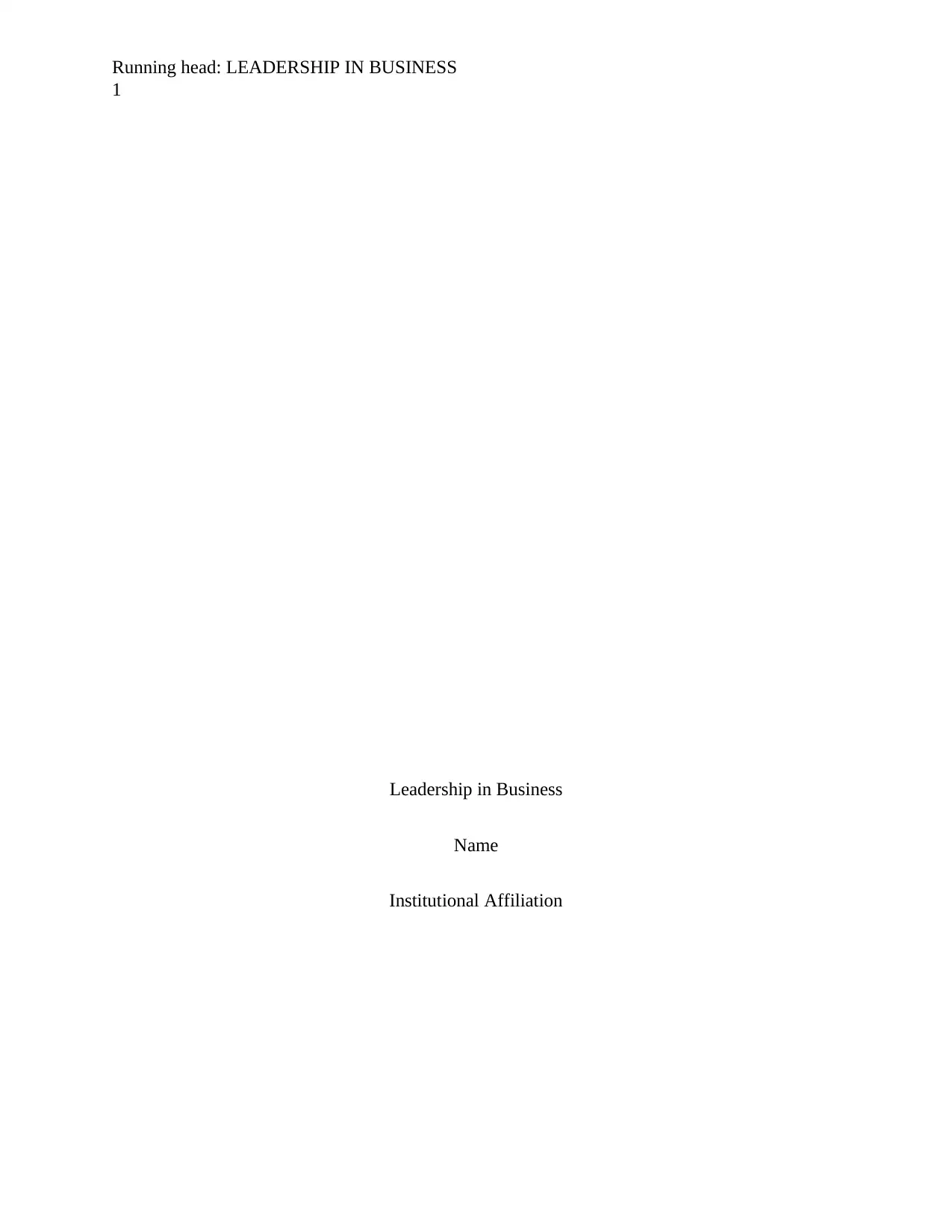
Running head: LEADERSHIP IN BUSINESS
1
Leadership in Business
Name
Institutional Affiliation
1
Leadership in Business
Name
Institutional Affiliation
Paraphrase This Document
Need a fresh take? Get an instant paraphrase of this document with our AI Paraphraser
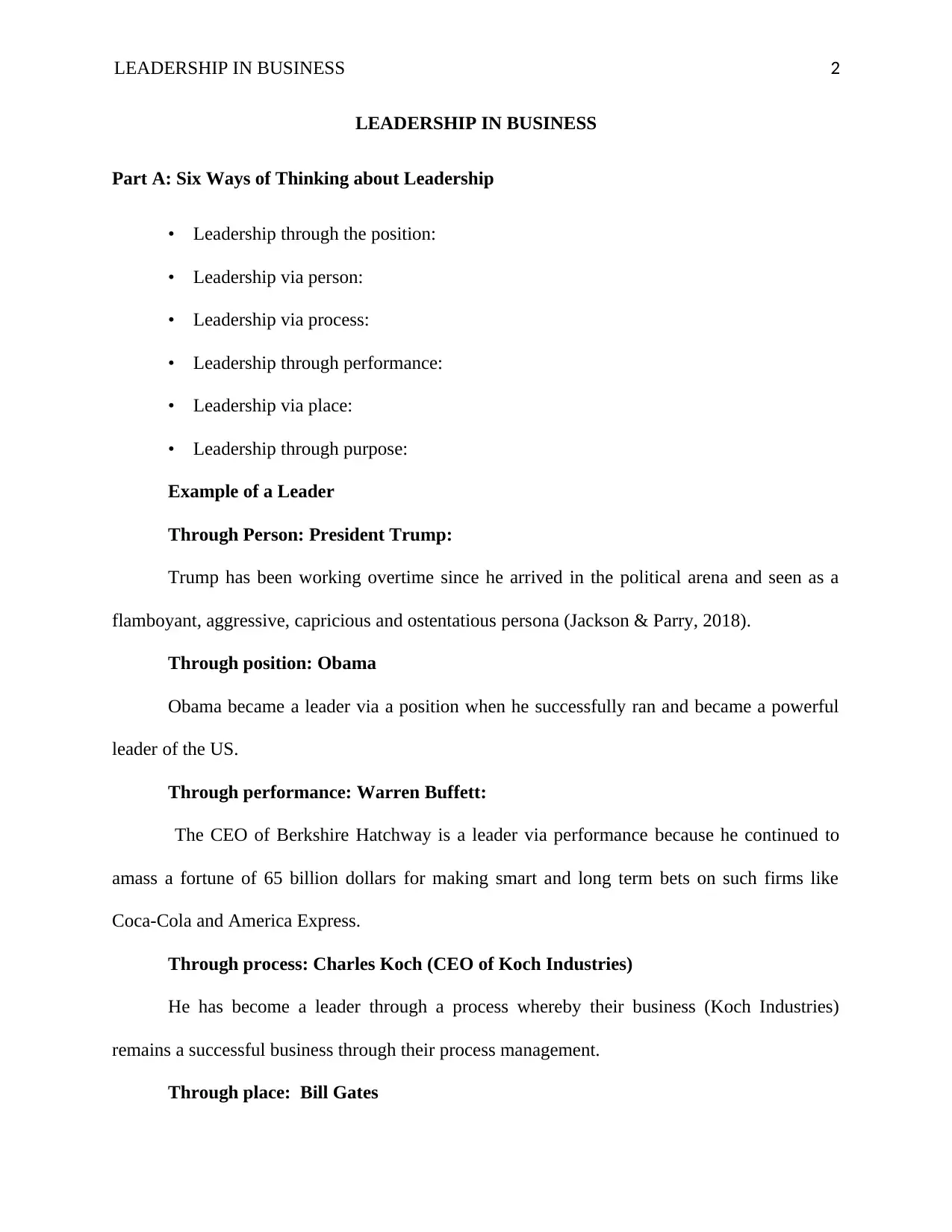
LEADERSHIP IN BUSINESS 2
LEADERSHIP IN BUSINESS
Part A: Six Ways of Thinking about Leadership
• Leadership through the position:
• Leadership via person:
• Leadership via process:
• Leadership through performance:
• Leadership via place:
• Leadership through purpose:
Example of a Leader
Through Person: President Trump:
Trump has been working overtime since he arrived in the political arena and seen as a
flamboyant, aggressive, capricious and ostentatious persona (Jackson & Parry, 2018).
Through position: Obama
Obama became a leader via a position when he successfully ran and became a powerful
leader of the US.
Through performance: Warren Buffett:
The CEO of Berkshire Hatchway is a leader via performance because he continued to
amass a fortune of 65 billion dollars for making smart and long term bets on such firms like
Coca-Cola and America Express.
Through process: Charles Koch (CEO of Koch Industries)
He has become a leader through a process whereby their business (Koch Industries)
remains a successful business through their process management.
Through place: Bill Gates
LEADERSHIP IN BUSINESS
Part A: Six Ways of Thinking about Leadership
• Leadership through the position:
• Leadership via person:
• Leadership via process:
• Leadership through performance:
• Leadership via place:
• Leadership through purpose:
Example of a Leader
Through Person: President Trump:
Trump has been working overtime since he arrived in the political arena and seen as a
flamboyant, aggressive, capricious and ostentatious persona (Jackson & Parry, 2018).
Through position: Obama
Obama became a leader via a position when he successfully ran and became a powerful
leader of the US.
Through performance: Warren Buffett:
The CEO of Berkshire Hatchway is a leader via performance because he continued to
amass a fortune of 65 billion dollars for making smart and long term bets on such firms like
Coca-Cola and America Express.
Through process: Charles Koch (CEO of Koch Industries)
He has become a leader through a process whereby their business (Koch Industries)
remains a successful business through their process management.
Through place: Bill Gates
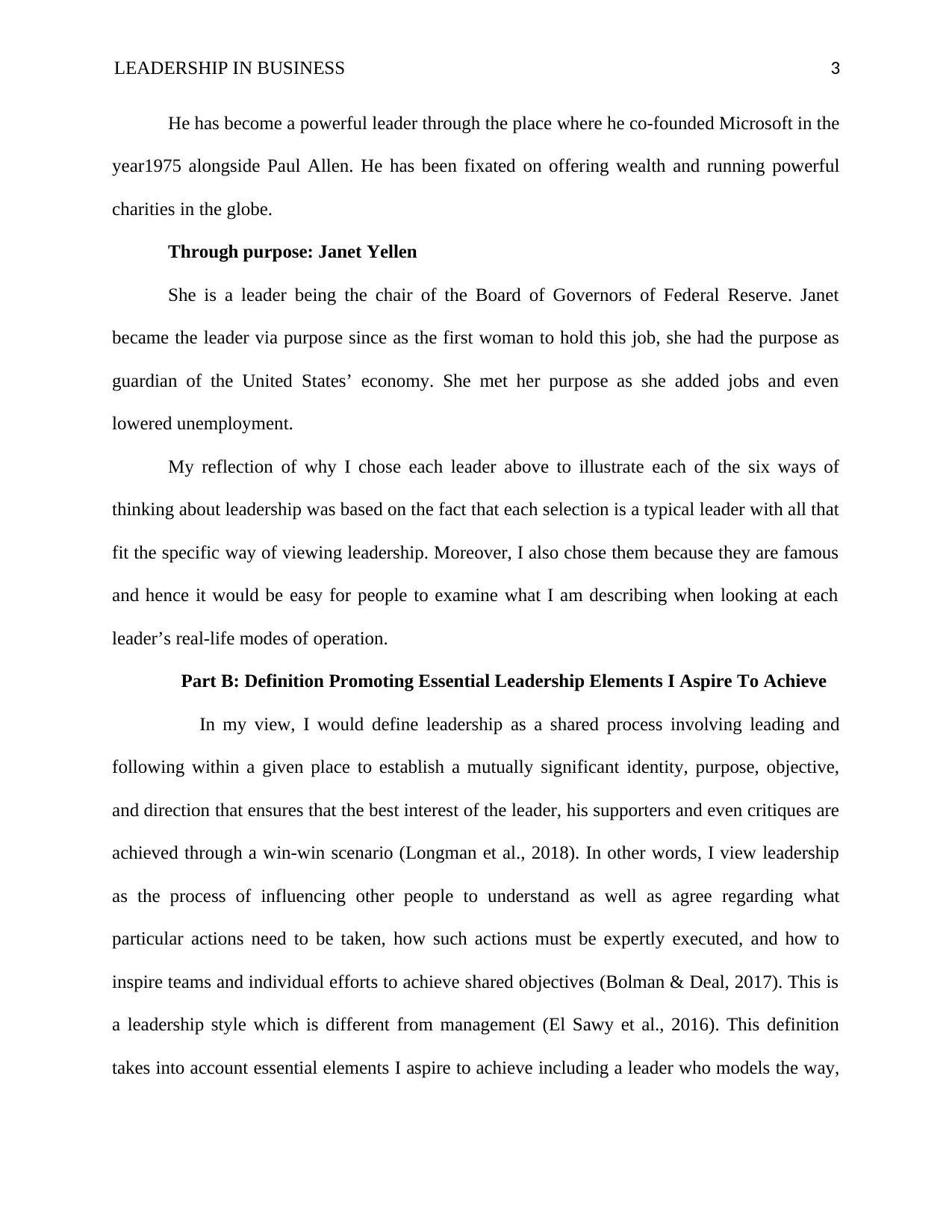
LEADERSHIP IN BUSINESS 3
He has become a powerful leader through the place where he co-founded Microsoft in the
year1975 alongside Paul Allen. He has been fixated on offering wealth and running powerful
charities in the globe.
Through purpose: Janet Yellen
She is a leader being the chair of the Board of Governors of Federal Reserve. Janet
became the leader via purpose since as the first woman to hold this job, she had the purpose as
guardian of the United States’ economy. She met her purpose as she added jobs and even
lowered unemployment.
My reflection of why I chose each leader above to illustrate each of the six ways of
thinking about leadership was based on the fact that each selection is a typical leader with all that
fit the specific way of viewing leadership. Moreover, I also chose them because they are famous
and hence it would be easy for people to examine what I am describing when looking at each
leader’s real-life modes of operation.
Part B: Definition Promoting Essential Leadership Elements I Aspire To Achieve
In my view, I would define leadership as a shared process involving leading and
following within a given place to establish a mutually significant identity, purpose, objective,
and direction that ensures that the best interest of the leader, his supporters and even critiques are
achieved through a win-win scenario (Longman et al., 2018). In other words, I view leadership
as the process of influencing other people to understand as well as agree regarding what
particular actions need to be taken, how such actions must be expertly executed, and how to
inspire teams and individual efforts to achieve shared objectives (Bolman & Deal, 2017). This is
a leadership style which is different from management (El Sawy et al., 2016). This definition
takes into account essential elements I aspire to achieve including a leader who models the way,
He has become a powerful leader through the place where he co-founded Microsoft in the
year1975 alongside Paul Allen. He has been fixated on offering wealth and running powerful
charities in the globe.
Through purpose: Janet Yellen
She is a leader being the chair of the Board of Governors of Federal Reserve. Janet
became the leader via purpose since as the first woman to hold this job, she had the purpose as
guardian of the United States’ economy. She met her purpose as she added jobs and even
lowered unemployment.
My reflection of why I chose each leader above to illustrate each of the six ways of
thinking about leadership was based on the fact that each selection is a typical leader with all that
fit the specific way of viewing leadership. Moreover, I also chose them because they are famous
and hence it would be easy for people to examine what I am describing when looking at each
leader’s real-life modes of operation.
Part B: Definition Promoting Essential Leadership Elements I Aspire To Achieve
In my view, I would define leadership as a shared process involving leading and
following within a given place to establish a mutually significant identity, purpose, objective,
and direction that ensures that the best interest of the leader, his supporters and even critiques are
achieved through a win-win scenario (Longman et al., 2018). In other words, I view leadership
as the process of influencing other people to understand as well as agree regarding what
particular actions need to be taken, how such actions must be expertly executed, and how to
inspire teams and individual efforts to achieve shared objectives (Bolman & Deal, 2017). This is
a leadership style which is different from management (El Sawy et al., 2016). This definition
takes into account essential elements I aspire to achieve including a leader who models the way,
⊘ This is a preview!⊘
Do you want full access?
Subscribe today to unlock all pages.

Trusted by 1+ million students worldwide
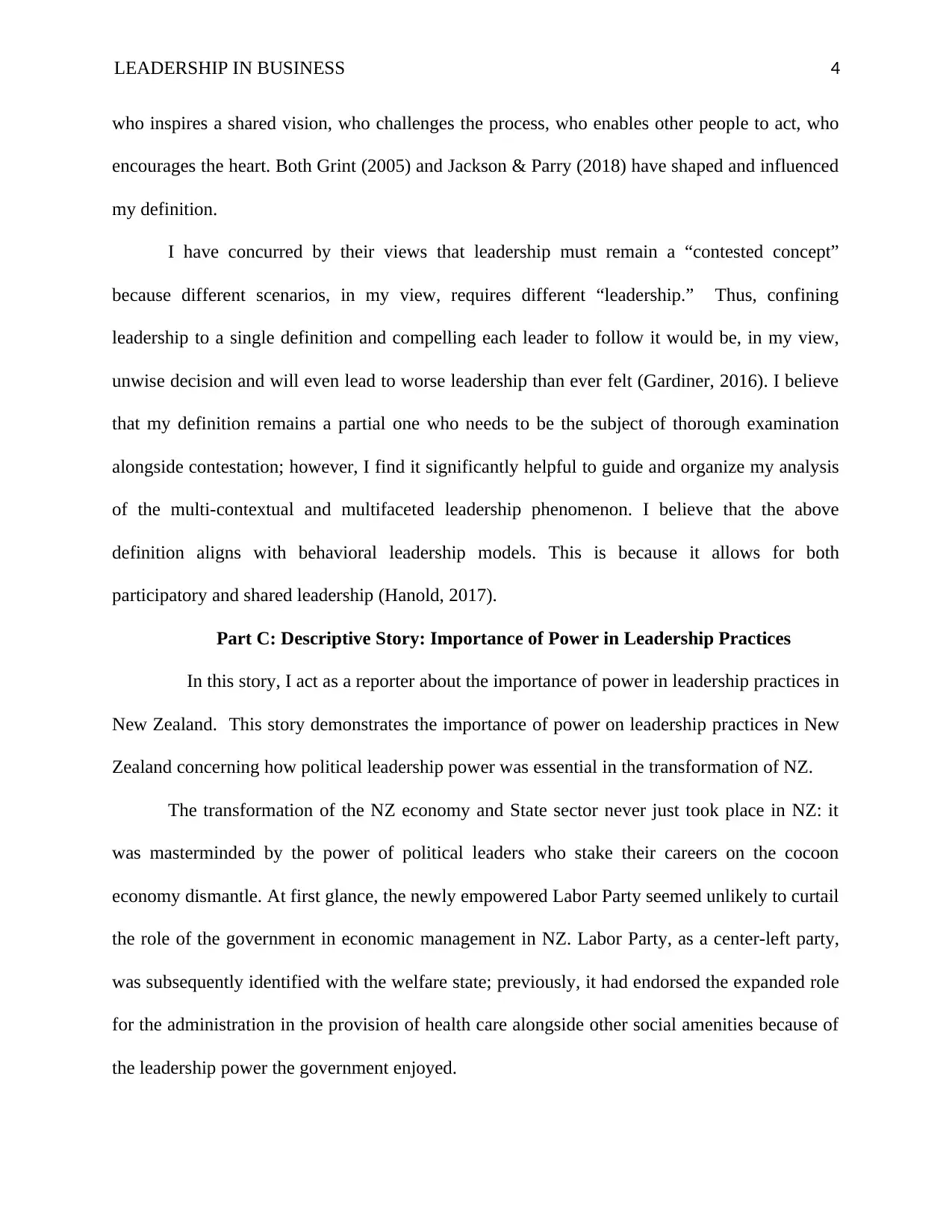
LEADERSHIP IN BUSINESS 4
who inspires a shared vision, who challenges the process, who enables other people to act, who
encourages the heart. Both Grint (2005) and Jackson & Parry (2018) have shaped and influenced
my definition.
I have concurred by their views that leadership must remain a “contested concept”
because different scenarios, in my view, requires different “leadership.” Thus, confining
leadership to a single definition and compelling each leader to follow it would be, in my view,
unwise decision and will even lead to worse leadership than ever felt (Gardiner, 2016). I believe
that my definition remains a partial one who needs to be the subject of thorough examination
alongside contestation; however, I find it significantly helpful to guide and organize my analysis
of the multi-contextual and multifaceted leadership phenomenon. I believe that the above
definition aligns with behavioral leadership models. This is because it allows for both
participatory and shared leadership (Hanold, 2017).
Part C: Descriptive Story: Importance of Power in Leadership Practices
In this story, I act as a reporter about the importance of power in leadership practices in
New Zealand. This story demonstrates the importance of power on leadership practices in New
Zealand concerning how political leadership power was essential in the transformation of NZ.
The transformation of the NZ economy and State sector never just took place in NZ: it
was masterminded by the power of political leaders who stake their careers on the cocoon
economy dismantle. At first glance, the newly empowered Labor Party seemed unlikely to curtail
the role of the government in economic management in NZ. Labor Party, as a center-left party,
was subsequently identified with the welfare state; previously, it had endorsed the expanded role
for the administration in the provision of health care alongside other social amenities because of
the leadership power the government enjoyed.
who inspires a shared vision, who challenges the process, who enables other people to act, who
encourages the heart. Both Grint (2005) and Jackson & Parry (2018) have shaped and influenced
my definition.
I have concurred by their views that leadership must remain a “contested concept”
because different scenarios, in my view, requires different “leadership.” Thus, confining
leadership to a single definition and compelling each leader to follow it would be, in my view,
unwise decision and will even lead to worse leadership than ever felt (Gardiner, 2016). I believe
that my definition remains a partial one who needs to be the subject of thorough examination
alongside contestation; however, I find it significantly helpful to guide and organize my analysis
of the multi-contextual and multifaceted leadership phenomenon. I believe that the above
definition aligns with behavioral leadership models. This is because it allows for both
participatory and shared leadership (Hanold, 2017).
Part C: Descriptive Story: Importance of Power in Leadership Practices
In this story, I act as a reporter about the importance of power in leadership practices in
New Zealand. This story demonstrates the importance of power on leadership practices in New
Zealand concerning how political leadership power was essential in the transformation of NZ.
The transformation of the NZ economy and State sector never just took place in NZ: it
was masterminded by the power of political leaders who stake their careers on the cocoon
economy dismantle. At first glance, the newly empowered Labor Party seemed unlikely to curtail
the role of the government in economic management in NZ. Labor Party, as a center-left party,
was subsequently identified with the welfare state; previously, it had endorsed the expanded role
for the administration in the provision of health care alongside other social amenities because of
the leadership power the government enjoyed.
Paraphrase This Document
Need a fresh take? Get an instant paraphrase of this document with our AI Paraphraser
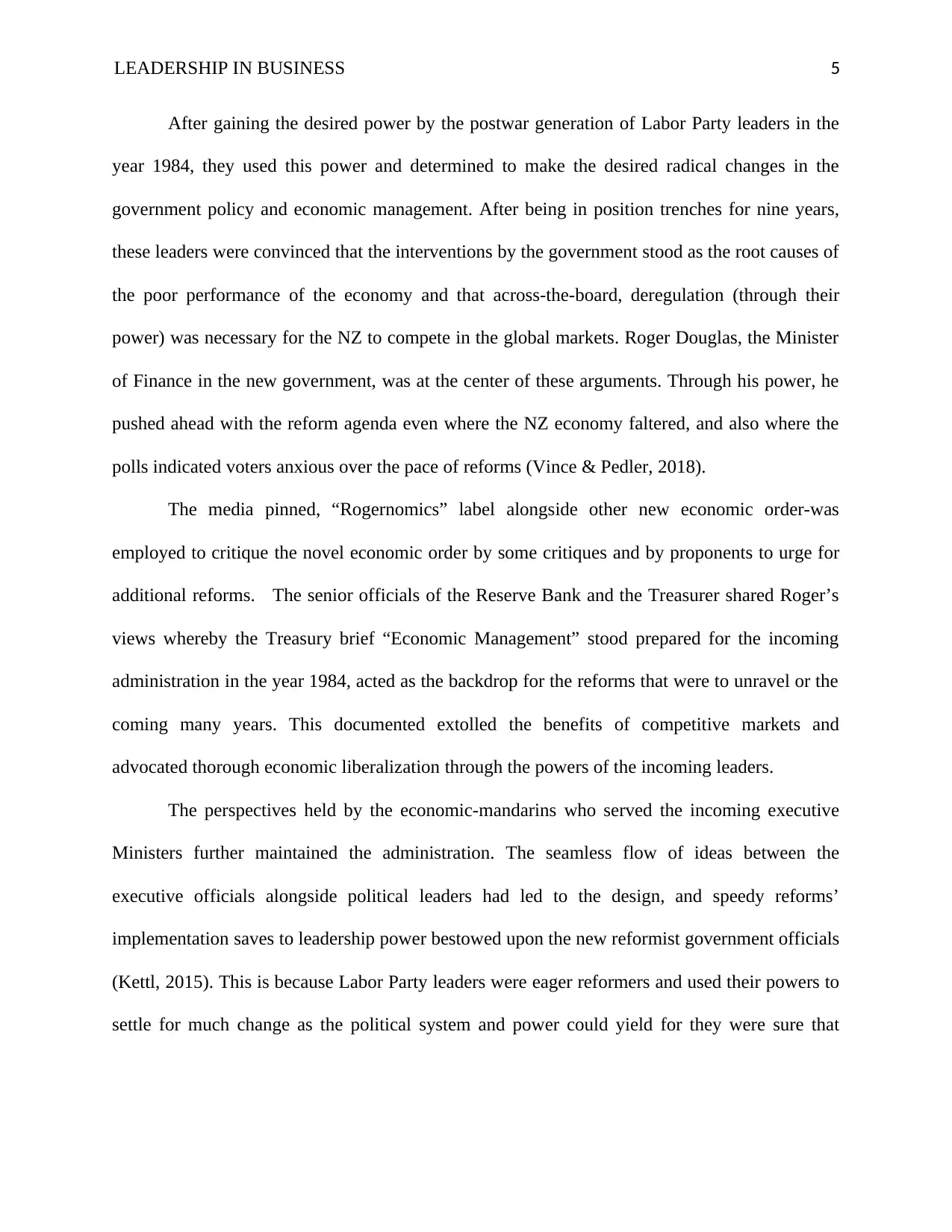
LEADERSHIP IN BUSINESS 5
After gaining the desired power by the postwar generation of Labor Party leaders in the
year 1984, they used this power and determined to make the desired radical changes in the
government policy and economic management. After being in position trenches for nine years,
these leaders were convinced that the interventions by the government stood as the root causes of
the poor performance of the economy and that across-the-board, deregulation (through their
power) was necessary for the NZ to compete in the global markets. Roger Douglas, the Minister
of Finance in the new government, was at the center of these arguments. Through his power, he
pushed ahead with the reform agenda even where the NZ economy faltered, and also where the
polls indicated voters anxious over the pace of reforms (Vince & Pedler, 2018).
The media pinned, “Rogernomics” label alongside other new economic order-was
employed to critique the novel economic order by some critiques and by proponents to urge for
additional reforms. The senior officials of the Reserve Bank and the Treasurer shared Roger’s
views whereby the Treasury brief “Economic Management” stood prepared for the incoming
administration in the year 1984, acted as the backdrop for the reforms that were to unravel or the
coming many years. This documented extolled the benefits of competitive markets and
advocated thorough economic liberalization through the powers of the incoming leaders.
The perspectives held by the economic-mandarins who served the incoming executive
Ministers further maintained the administration. The seamless flow of ideas between the
executive officials alongside political leaders had led to the design, and speedy reforms’
implementation saves to leadership power bestowed upon the new reformist government officials
(Kettl, 2015). This is because Labor Party leaders were eager reformers and used their powers to
settle for much change as the political system and power could yield for they were sure that
After gaining the desired power by the postwar generation of Labor Party leaders in the
year 1984, they used this power and determined to make the desired radical changes in the
government policy and economic management. After being in position trenches for nine years,
these leaders were convinced that the interventions by the government stood as the root causes of
the poor performance of the economy and that across-the-board, deregulation (through their
power) was necessary for the NZ to compete in the global markets. Roger Douglas, the Minister
of Finance in the new government, was at the center of these arguments. Through his power, he
pushed ahead with the reform agenda even where the NZ economy faltered, and also where the
polls indicated voters anxious over the pace of reforms (Vince & Pedler, 2018).
The media pinned, “Rogernomics” label alongside other new economic order-was
employed to critique the novel economic order by some critiques and by proponents to urge for
additional reforms. The senior officials of the Reserve Bank and the Treasurer shared Roger’s
views whereby the Treasury brief “Economic Management” stood prepared for the incoming
administration in the year 1984, acted as the backdrop for the reforms that were to unravel or the
coming many years. This documented extolled the benefits of competitive markets and
advocated thorough economic liberalization through the powers of the incoming leaders.
The perspectives held by the economic-mandarins who served the incoming executive
Ministers further maintained the administration. The seamless flow of ideas between the
executive officials alongside political leaders had led to the design, and speedy reforms’
implementation saves to leadership power bestowed upon the new reformist government officials
(Kettl, 2015). This is because Labor Party leaders were eager reformers and used their powers to
settle for much change as the political system and power could yield for they were sure that
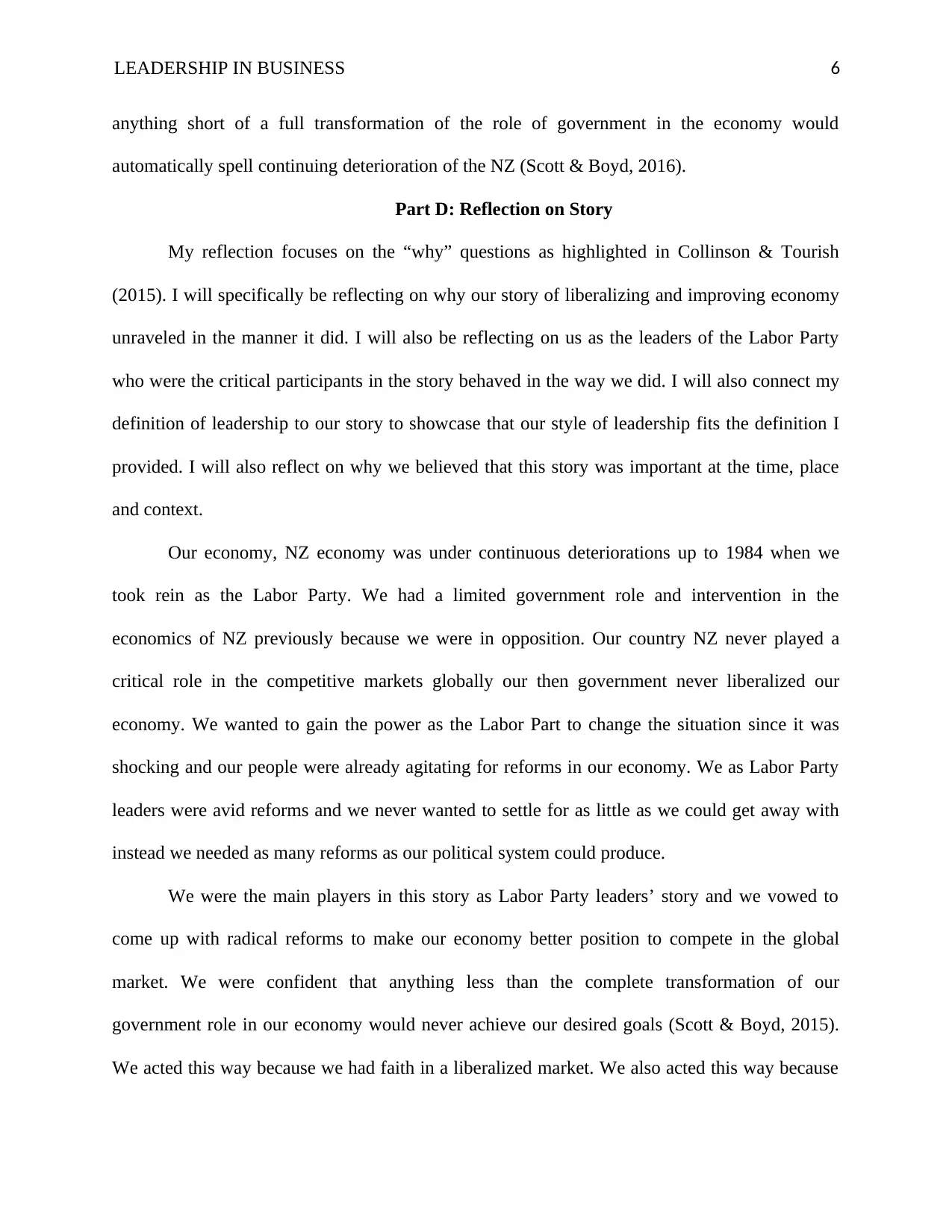
LEADERSHIP IN BUSINESS 6
anything short of a full transformation of the role of government in the economy would
automatically spell continuing deterioration of the NZ (Scott & Boyd, 2016).
Part D: Reflection on Story
My reflection focuses on the “why” questions as highlighted in Collinson & Tourish
(2015). I will specifically be reflecting on why our story of liberalizing and improving economy
unraveled in the manner it did. I will also be reflecting on us as the leaders of the Labor Party
who were the critical participants in the story behaved in the way we did. I will also connect my
definition of leadership to our story to showcase that our style of leadership fits the definition I
provided. I will also reflect on why we believed that this story was important at the time, place
and context.
Our economy, NZ economy was under continuous deteriorations up to 1984 when we
took rein as the Labor Party. We had a limited government role and intervention in the
economics of NZ previously because we were in opposition. Our country NZ never played a
critical role in the competitive markets globally our then government never liberalized our
economy. We wanted to gain the power as the Labor Part to change the situation since it was
shocking and our people were already agitating for reforms in our economy. We as Labor Party
leaders were avid reforms and we never wanted to settle for as little as we could get away with
instead we needed as many reforms as our political system could produce.
We were the main players in this story as Labor Party leaders’ story and we vowed to
come up with radical reforms to make our economy better position to compete in the global
market. We were confident that anything less than the complete transformation of our
government role in our economy would never achieve our desired goals (Scott & Boyd, 2015).
We acted this way because we had faith in a liberalized market. We also acted this way because
anything short of a full transformation of the role of government in the economy would
automatically spell continuing deterioration of the NZ (Scott & Boyd, 2016).
Part D: Reflection on Story
My reflection focuses on the “why” questions as highlighted in Collinson & Tourish
(2015). I will specifically be reflecting on why our story of liberalizing and improving economy
unraveled in the manner it did. I will also be reflecting on us as the leaders of the Labor Party
who were the critical participants in the story behaved in the way we did. I will also connect my
definition of leadership to our story to showcase that our style of leadership fits the definition I
provided. I will also reflect on why we believed that this story was important at the time, place
and context.
Our economy, NZ economy was under continuous deteriorations up to 1984 when we
took rein as the Labor Party. We had a limited government role and intervention in the
economics of NZ previously because we were in opposition. Our country NZ never played a
critical role in the competitive markets globally our then government never liberalized our
economy. We wanted to gain the power as the Labor Part to change the situation since it was
shocking and our people were already agitating for reforms in our economy. We as Labor Party
leaders were avid reforms and we never wanted to settle for as little as we could get away with
instead we needed as many reforms as our political system could produce.
We were the main players in this story as Labor Party leaders’ story and we vowed to
come up with radical reforms to make our economy better position to compete in the global
market. We were confident that anything less than the complete transformation of our
government role in our economy would never achieve our desired goals (Scott & Boyd, 2015).
We acted this way because we had faith in a liberalized market. We also acted this way because
⊘ This is a preview!⊘
Do you want full access?
Subscribe today to unlock all pages.

Trusted by 1+ million students worldwide
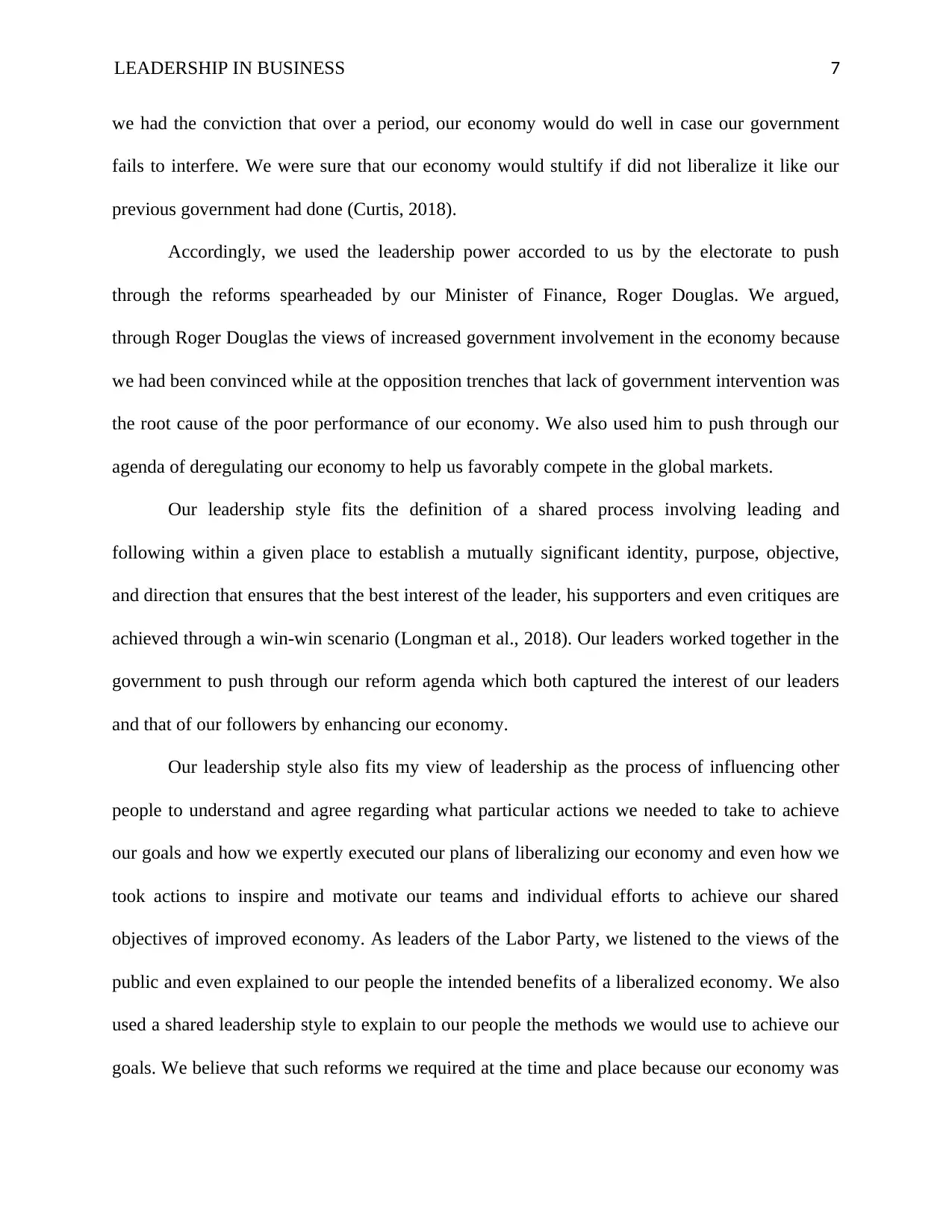
LEADERSHIP IN BUSINESS 7
we had the conviction that over a period, our economy would do well in case our government
fails to interfere. We were sure that our economy would stultify if did not liberalize it like our
previous government had done (Curtis, 2018).
Accordingly, we used the leadership power accorded to us by the electorate to push
through the reforms spearheaded by our Minister of Finance, Roger Douglas. We argued,
through Roger Douglas the views of increased government involvement in the economy because
we had been convinced while at the opposition trenches that lack of government intervention was
the root cause of the poor performance of our economy. We also used him to push through our
agenda of deregulating our economy to help us favorably compete in the global markets.
Our leadership style fits the definition of a shared process involving leading and
following within a given place to establish a mutually significant identity, purpose, objective,
and direction that ensures that the best interest of the leader, his supporters and even critiques are
achieved through a win-win scenario (Longman et al., 2018). Our leaders worked together in the
government to push through our reform agenda which both captured the interest of our leaders
and that of our followers by enhancing our economy.
Our leadership style also fits my view of leadership as the process of influencing other
people to understand and agree regarding what particular actions we needed to take to achieve
our goals and how we expertly executed our plans of liberalizing our economy and even how we
took actions to inspire and motivate our teams and individual efforts to achieve our shared
objectives of improved economy. As leaders of the Labor Party, we listened to the views of the
public and even explained to our people the intended benefits of a liberalized economy. We also
used a shared leadership style to explain to our people the methods we would use to achieve our
goals. We believe that such reforms we required at the time and place because our economy was
we had the conviction that over a period, our economy would do well in case our government
fails to interfere. We were sure that our economy would stultify if did not liberalize it like our
previous government had done (Curtis, 2018).
Accordingly, we used the leadership power accorded to us by the electorate to push
through the reforms spearheaded by our Minister of Finance, Roger Douglas. We argued,
through Roger Douglas the views of increased government involvement in the economy because
we had been convinced while at the opposition trenches that lack of government intervention was
the root cause of the poor performance of our economy. We also used him to push through our
agenda of deregulating our economy to help us favorably compete in the global markets.
Our leadership style fits the definition of a shared process involving leading and
following within a given place to establish a mutually significant identity, purpose, objective,
and direction that ensures that the best interest of the leader, his supporters and even critiques are
achieved through a win-win scenario (Longman et al., 2018). Our leaders worked together in the
government to push through our reform agenda which both captured the interest of our leaders
and that of our followers by enhancing our economy.
Our leadership style also fits my view of leadership as the process of influencing other
people to understand and agree regarding what particular actions we needed to take to achieve
our goals and how we expertly executed our plans of liberalizing our economy and even how we
took actions to inspire and motivate our teams and individual efforts to achieve our shared
objectives of improved economy. As leaders of the Labor Party, we listened to the views of the
public and even explained to our people the intended benefits of a liberalized economy. We also
used a shared leadership style to explain to our people the methods we would use to achieve our
goals. We believe that such reforms we required at the time and place because our economy was
Paraphrase This Document
Need a fresh take? Get an instant paraphrase of this document with our AI Paraphraser

LEADERSHIP IN BUSINESS 8
diminishing and continuously showed poor performance making our country unattractive for
trade due to stringent regulation (Nabers, 2016).
diminishing and continuously showed poor performance making our country unattractive for
trade due to stringent regulation (Nabers, 2016).
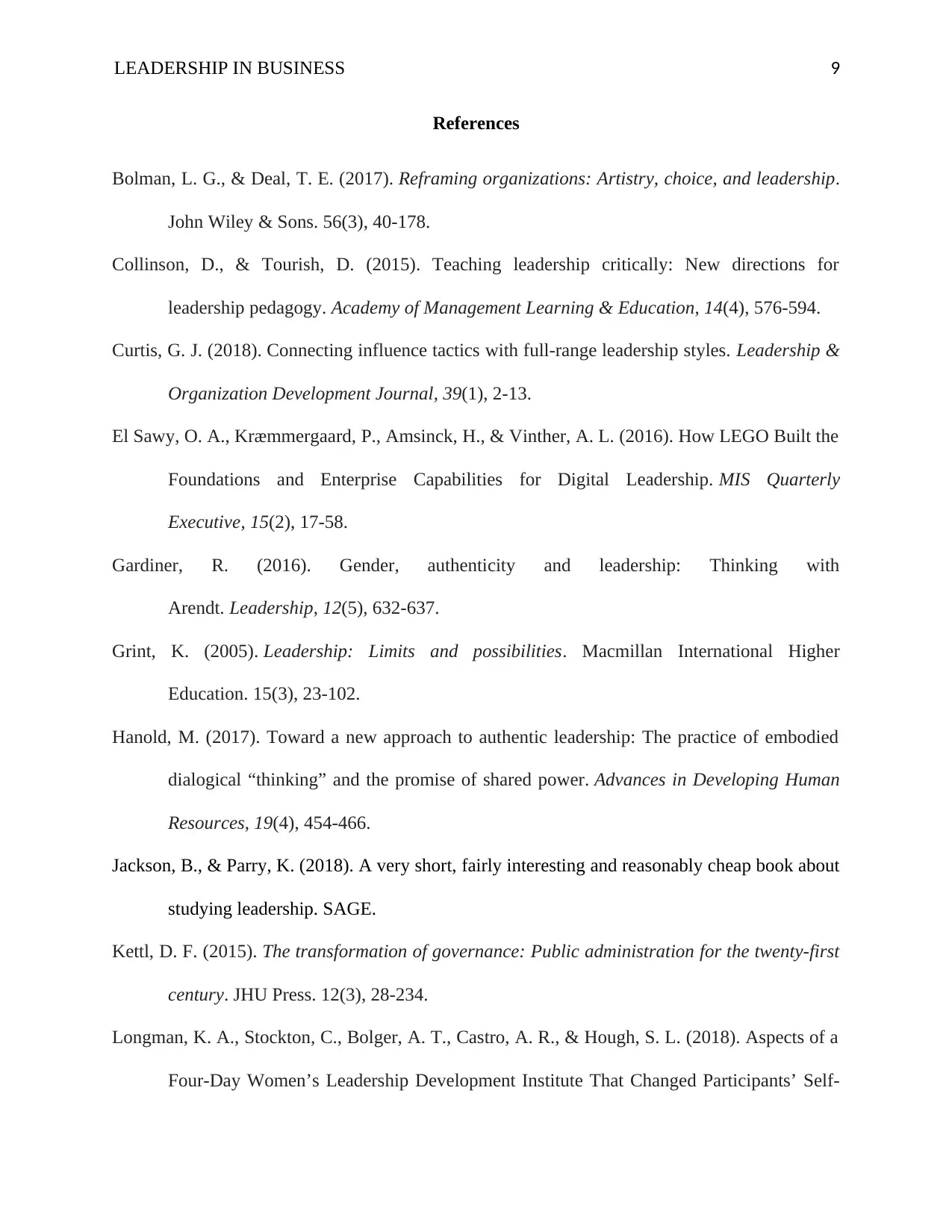
LEADERSHIP IN BUSINESS 9
References
Bolman, L. G., & Deal, T. E. (2017). Reframing organizations: Artistry, choice, and leadership.
John Wiley & Sons. 56(3), 40-178.
Collinson, D., & Tourish, D. (2015). Teaching leadership critically: New directions for
leadership pedagogy. Academy of Management Learning & Education, 14(4), 576-594.
Curtis, G. J. (2018). Connecting influence tactics with full-range leadership styles. Leadership &
Organization Development Journal, 39(1), 2-13.
El Sawy, O. A., Kræmmergaard, P., Amsinck, H., & Vinther, A. L. (2016). How LEGO Built the
Foundations and Enterprise Capabilities for Digital Leadership. MIS Quarterly
Executive, 15(2), 17-58.
Gardiner, R. (2016). Gender, authenticity and leadership: Thinking with
Arendt. Leadership, 12(5), 632-637.
Grint, K. (2005). Leadership: Limits and possibilities. Macmillan International Higher
Education. 15(3), 23-102.
Hanold, M. (2017). Toward a new approach to authentic leadership: The practice of embodied
dialogical “thinking” and the promise of shared power. Advances in Developing Human
Resources, 19(4), 454-466.
Jackson, B., & Parry, K. (2018). A very short, fairly interesting and reasonably cheap book about
studying leadership. SAGE.
Kettl, D. F. (2015). The transformation of governance: Public administration for the twenty-first
century. JHU Press. 12(3), 28-234.
Longman, K. A., Stockton, C., Bolger, A. T., Castro, A. R., & Hough, S. L. (2018). Aspects of a
Four-Day Women’s Leadership Development Institute That Changed Participants’ Self-
References
Bolman, L. G., & Deal, T. E. (2017). Reframing organizations: Artistry, choice, and leadership.
John Wiley & Sons. 56(3), 40-178.
Collinson, D., & Tourish, D. (2015). Teaching leadership critically: New directions for
leadership pedagogy. Academy of Management Learning & Education, 14(4), 576-594.
Curtis, G. J. (2018). Connecting influence tactics with full-range leadership styles. Leadership &
Organization Development Journal, 39(1), 2-13.
El Sawy, O. A., Kræmmergaard, P., Amsinck, H., & Vinther, A. L. (2016). How LEGO Built the
Foundations and Enterprise Capabilities for Digital Leadership. MIS Quarterly
Executive, 15(2), 17-58.
Gardiner, R. (2016). Gender, authenticity and leadership: Thinking with
Arendt. Leadership, 12(5), 632-637.
Grint, K. (2005). Leadership: Limits and possibilities. Macmillan International Higher
Education. 15(3), 23-102.
Hanold, M. (2017). Toward a new approach to authentic leadership: The practice of embodied
dialogical “thinking” and the promise of shared power. Advances in Developing Human
Resources, 19(4), 454-466.
Jackson, B., & Parry, K. (2018). A very short, fairly interesting and reasonably cheap book about
studying leadership. SAGE.
Kettl, D. F. (2015). The transformation of governance: Public administration for the twenty-first
century. JHU Press. 12(3), 28-234.
Longman, K. A., Stockton, C., Bolger, A. T., Castro, A. R., & Hough, S. L. (2018). Aspects of a
Four-Day Women’s Leadership Development Institute That Changed Participants’ Self-
⊘ This is a preview!⊘
Do you want full access?
Subscribe today to unlock all pages.

Trusted by 1+ million students worldwide
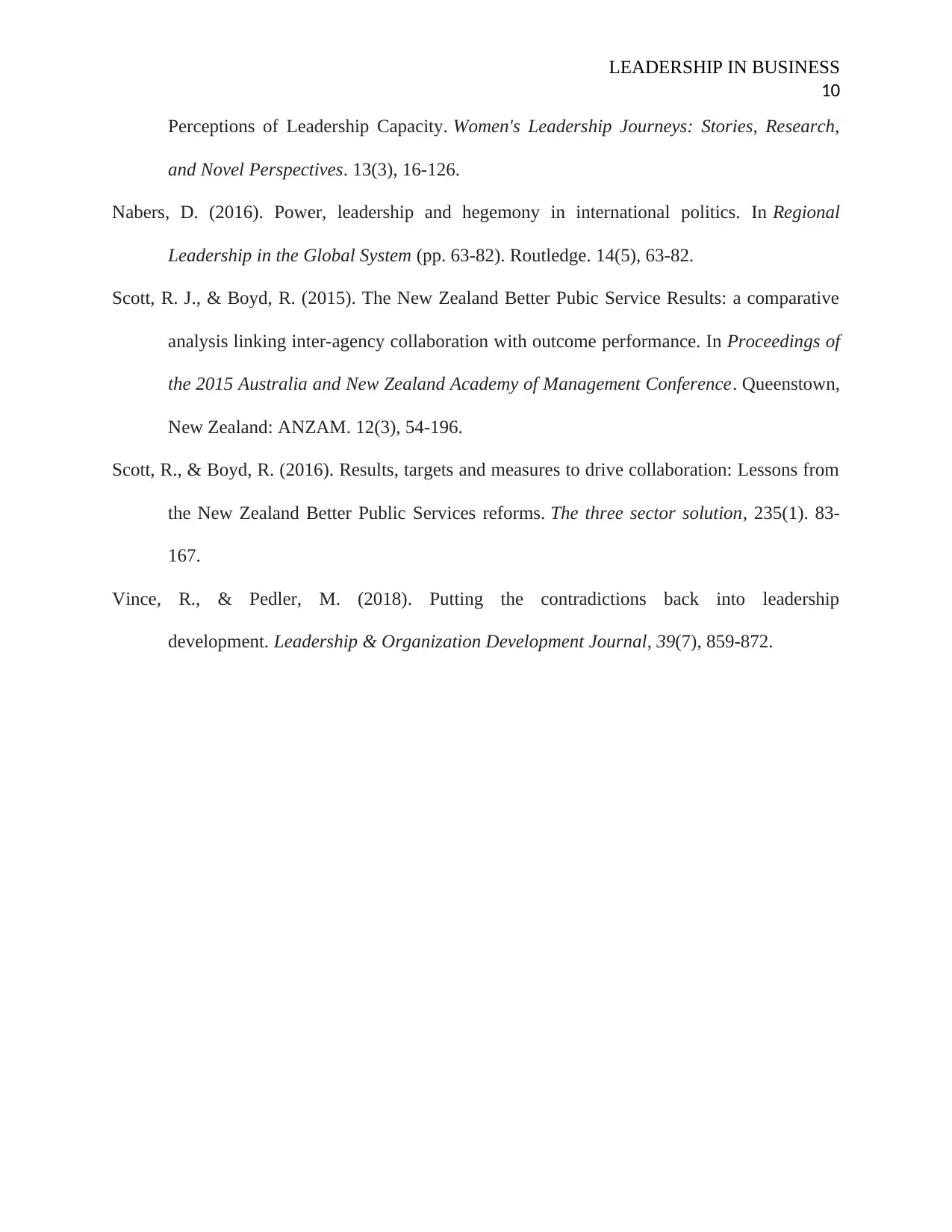
LEADERSHIP IN BUSINESS
10
Perceptions of Leadership Capacity. Women's Leadership Journeys: Stories, Research,
and Novel Perspectives. 13(3), 16-126.
Nabers, D. (2016). Power, leadership and hegemony in international politics. In Regional
Leadership in the Global System (pp. 63-82). Routledge. 14(5), 63-82.
Scott, R. J., & Boyd, R. (2015). The New Zealand Better Pubic Service Results: a comparative
analysis linking inter-agency collaboration with outcome performance. In Proceedings of
the 2015 Australia and New Zealand Academy of Management Conference. Queenstown,
New Zealand: ANZAM. 12(3), 54-196.
Scott, R., & Boyd, R. (2016). Results, targets and measures to drive collaboration: Lessons from
the New Zealand Better Public Services reforms. The three sector solution, 235(1). 83-
167.
Vince, R., & Pedler, M. (2018). Putting the contradictions back into leadership
development. Leadership & Organization Development Journal, 39(7), 859-872.
10
Perceptions of Leadership Capacity. Women's Leadership Journeys: Stories, Research,
and Novel Perspectives. 13(3), 16-126.
Nabers, D. (2016). Power, leadership and hegemony in international politics. In Regional
Leadership in the Global System (pp. 63-82). Routledge. 14(5), 63-82.
Scott, R. J., & Boyd, R. (2015). The New Zealand Better Pubic Service Results: a comparative
analysis linking inter-agency collaboration with outcome performance. In Proceedings of
the 2015 Australia and New Zealand Academy of Management Conference. Queenstown,
New Zealand: ANZAM. 12(3), 54-196.
Scott, R., & Boyd, R. (2016). Results, targets and measures to drive collaboration: Lessons from
the New Zealand Better Public Services reforms. The three sector solution, 235(1). 83-
167.
Vince, R., & Pedler, M. (2018). Putting the contradictions back into leadership
development. Leadership & Organization Development Journal, 39(7), 859-872.
1 out of 10
Related Documents
Your All-in-One AI-Powered Toolkit for Academic Success.
+13062052269
info@desklib.com
Available 24*7 on WhatsApp / Email
![[object Object]](/_next/static/media/star-bottom.7253800d.svg)
Unlock your academic potential
Copyright © 2020–2025 A2Z Services. All Rights Reserved. Developed and managed by ZUCOL.



